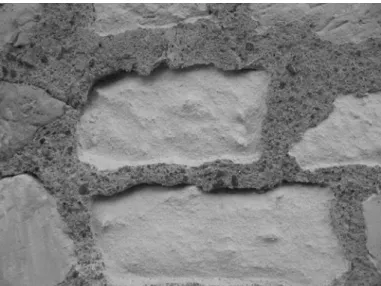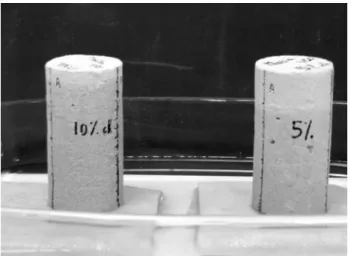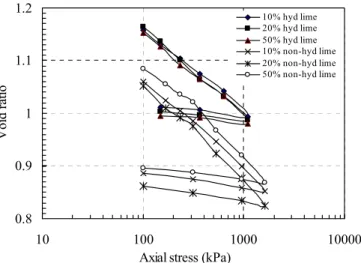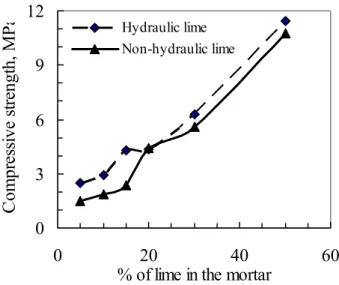HAL Id: hal-00093489
https://hal-insu.archives-ouvertes.fr/hal-00093489
Submitted on 13 Sep 2006
HAL is a multi-disciplinary open access archive for the deposit and dissemination of sci-entific research documents, whether they are pub-lished or not. The documents may come from teaching and research institutions in France or abroad, or from public or private research centers.
L’archive ouverte pluridisciplinaire HAL, est destinée au dépôt et à la diffusion de documents scientifiques de niveau recherche, publiés ou non, émanant des établissements d’enseignement et de recherche français ou étrangers, des laboratoires publics ou privés.
Physical-mechanical characterization of hydraulic and
non-hydraulic lime based mortars for a French porous
limestone
Muzahim Al-Mukhtar, Kévin Beck
To cite this version:
Muzahim Al-Mukhtar, Kévin Beck. Physical-mechanical characterization of hydraulic and non-hydraulic lime based mortars for a French porous limestone. 2006, 6p. �hal-00093489�
1 INTRODUCTION
Sedimentary rocks such as limestones have been commonly used in the construction of several his-torically important monuments and structures for many centuries in various parts of the world. These structures are standing examples of our cultural heri-tage and civilization. For this reason, such structures should be preserved and well maintained for our fu-ture generations. However, due to the action of wa-ter and the influence of environment and pollution, these structures gradually deteriorate over a period of time. Several millions of dollars are annually spent for the maintenance and repair works of these valuable structures in various parts of the world. There are various construction methods that have been developed based on experience to repair these structures. Investigations in this direction has shown suitable mortars can be suggested for repair works by better understanding the mechanical, physical and chemical properties of the mortars in addition to a rigorous evaluation process of their performance un-der varying environmental conditions. Analysis of numerous cases of degradation of the architectural monuments in Loire Valley (France) show that the damages often find their origin to the type of mortar that is used in the construction. From the second half of the 20th century, restoration of several historical monuments was undertaken mainly using cement mortars as joints between stones. Several damages
were attributed due to the use of cement mortar par-ticularly when used with limestones (Rautureau 2001). Studies have shown chemical characteristics of cement (essentially its alkaline salts content) are incompatible with limestone. Furthermore, cement mortars are hard, stiff and have a high adhesion force which partly contributes towards the increase in the brittleness property of stones. In addition, an impermeable mortar favors the accumulation of wa-ter in the stone and constitutes a zone that increases dissolution and recrystallization (Fig. 1).
Lime based mortars are more commonly used since ancient times in the construction (Egyptians, Chi-nese, Phoeniciens) (Furlan & Bisseger 1975; Biscon-tin et al. 2002, Fassina et al. 2002). Conventionally, two types of lime are used as mortars (i) non-hydraulic lime (also called hydrated lime) made from relatively pure limestones which mainly harden due to carbonation and (ii) natural hydraulic lime made from limestone with reactive silica and alu-minium impurities which harden and set in the pres-ence of water.
This paper presents the behaviour of lime and exam-ines their compatibility with the tuffeau, which is a typical porous limestone which is available plentiful in the Loire Valley (France). The prepared mortar is composed with non-hydraulic or hydraulic limes and aggregates (powder) obtained from the stone tuffeau. Mortars prepared using the same material (i.e., tuf-feau) will have similar physico-chemical and
hydro-Physical-mechanical characterization of hydraulic and non-hydraulic
lime based mortars for a French porous limestone
M. AL-MUKHTAR
1* & K. BECK
1,21Centre de Recherche sur la Matière Divisée, Ecole Polytechnique de l'Université d'Orléans, CNRS - CRMD,
1B rue de la Férollerie, 45071 Orléans Cedex 2, France.
2Institut des Sciences de la Terre d’Orléans, CNRS-ISTO, 1A rue de la Férollerie, 45071 Orléans Cedex 2,
France.
* muzahim@cnrs-orleans.fr
ABSTRACT: The focus of the study presented in this paper is to provide reliable criteria that can be used to estimate the degree of compatibility between the French limestone tuffeau and mortar. It is suggested through this study to use the same parent material (i.e., tuffeau) as mortar. The mortar used in this study is composed of non-hydraulic (hydrated) lime or hydraulic lime and aggregates obtained from fragments and powder of the tuffeau stone. Water transfer properties and mechanical behaviour of the mortars are evaluated and compared with the original stone Tuffeau. Based on these studies, some key guidelines are provided such that a mortar that is compatible with properties of Tuffeau and can be prepared and used as construction material of monu-ments and maintenance purposes.
mechanical properties and compatible with those of the tuffeau stone. Mechanical behavioural properties (strength properties in compression and tension) and hydraulic property (mainly capillary imbibition) were evaluated for mortar samples composed with different proportions of lime.
Figure 1: Deterioration of a tuffeau stone associated with the use of cement joint mortar
2. MATERIALS AND METHODS
2.1 Mineralogical and textural characterisation of the building stone
The Tuffeau stone used in the study is a porous sedimentary white limestone (Table 1). The princi-pal minerals present in it are calcite (CaCO3) and
sil-ica (SiO2) in the form of opal cristobalite-tridymite
and quartz. The other minerals present in the stone are micas, clays and detritic minerals such as TiO2.
The texture of stones forms complex porous network (Beck et al., 2003). The arrangement of larger and smaller grains within the stones contributes to macropores and micropores within the stone struc-ture.
Table 1: Main characteristics of the Tuffeau (Beck et al., 2003).
Parameter Tuffeau Mineralogical
composition Calcite ≅ 50%, Opal CT ≅ 30%, Quartz ≅ 10%, Clay and Mica ≅10% Skeletal density
(g/cm3) 2.55
Bulk dry density
(g/cm3) 1.31
Porosity ≅ 48%
2.2 Mortar components characterisation
The mortar is composed of Tuffeau limestone pow-der and lime. The powpow-der of Tuffeau is obtained by crushing of the stone in a grinder-mixture followed by sifting to achieve a fine powder by passing through a sieve of 315 µm diameter. The hydraulic and non-hydraulic lime powders that are used are light and have low densities.Figure 2 shows the par-ticle size distributions obtained from laser granu-lometry of Tuffeau powder of the two limes used in this study. From this figure it can be seen that Tuf-feau particles are fine and well graded. Hydraulic lime particles are very close to that of Tuffeau. Non-hydraulic lime particles are less than 50 µm in size and are smaller than Tuffeau particles. However, the dimensions of all particles that are used in the prepa-ration of the mortar are relatively small with sizes ranging between 1 to 100 µm.
Figure 2: Particle size distribution of powders from laser granulometry
2.3 Mortar preparation
The test specimens of mortar consisted of only two components: powder of Tuffeau and lime (hydraulic and non-hydraulic lime). The effect of varying the concentration of lime (i.e. 5 – 50%) in the mortar paste was studied. Water content of the mortar pastes was set at 50% so that the mortar paste would have a good workable consistency no matter what the concentration of lime. Two different types of samples were prepared. In the first set, prepared samples are 80 mm in height and 40 mm in diame-ter. They were compacted in a cylindrical cast of 40 mm in diameter under a specific load in order to achieve desired dry bulk density at 1.2 g/cm3 (close
to that of the stone) and allowed to set for two days. The specimens were then remoulded and placed in a hermitic chamber at a relative humidity of 100% and constant temperature of 20°C for 25 more days in order to avoid desaturation phenomena. And finally, they were dried in an oven at 105°C for a period of
0 20 40 60 80 100 0,1 1 10 100 1000 Particle size, µm Vo lu m e, % Non-hydraulic lime Hydraulic lime Tuffeau pow der
24 hours. For this reason, the specimens were al-lowed to harden for 28 days before being tested. In the second series (used only for the adhesion tests) a mortar of 10 mm of thickness is placed on cylindrical stone sample (diameter: 40 mm and height: 35 mm) without compaction. During setting, the mixture of stone/mortar is placed in a bag and sealed for a period of 7 days in order to prevent evaporation. Then, samples are unpacked and kept in a desiccator (at 76% relative humidity and 20°C temperature) for a period of 21 days before testing.
2.4 Mechanical tests
A number of mechanical tests (Beck & Al-Mukhtar, 2006) were carried out (Fig. 3) on cylindrical sam-ples of mortar which include: compressive strength (Standard AFNOR P94-420) and tensile strength called also as cylinder splitting test (Standard AF-NOR P94-422). In addition adhesion test (Standard AFNOR NF EN 1015-12) was conducted on the mortar paste placed on cylindrical stone sample without compaction. An increasing force is applied at a loading rate of 0.05 mm/min for compressive and tensile tests. The samples were loaded at a rate of 0.5 MPa/min using an Instron 4485 press to de-termine the rupture in the tested samples (adhesive test).
The volumetric deformation behaviour of the sam-ples was also determined. The reduction in volume of initial saturated samples when subjected to a rela-tive humidity of 32% (humidity induced by using a saturated salt solution in a desiccator’s) was deter-mined. These tests are referred as “preliminary shrinkage tests” in a later section in the paper. This terminology was used as authors feel that more test-ing is required in this direction.
Figure 3: Mortar samples during compressive, tensile and ad-hesive tests respectively
2.5 Water absorption-imbibition test
In this test (standard AFNOR B10-613), previously dried cylindrical samples are placed in a hermetic tank at the bottom of which distilled water level is
maintained constant during entire period of the test (Fig. 4). The mass of wet samples and the height of the capillary front are measured at increasing inter-vals of times. The imbibition coefficients A and B correspond to the slopes of the curves of mass up-take and rise of the capillary front according to the square root of elapsed time.
Figure 4: Mortar samples during imbibition tests
4. RESULTS
4.1 Compressibility of the mortar
One dimensional compression tests (oedometer tests – Fig. 5) were performed on mortar pastes (lateral deformation are prevented during the test) to deter-mine its compressibility behaviour under drained conditions. The mortar paste was prepared using the different concentrations of lime at a solid/liquid ratio of 1:1. The duration of this test is about 2-3 hours which is much lower than the initial setting time of the tested paste (> 10 hours). The sample pastes are placed in 65 mm diameter oedometer specimen rings. The axial stress is applied and is maintained until axial strain stabilizes. At the end of the loading, the height of sample is measured and dry bulk den-sity and poroden-sity are determined from the initial properties of the test specimen.
Results are presented in terms of void ratio (e) ver-sus axial applied stresses (Fig. 5). The results dem-onstrate that the void ratio reduces as the axial stresses are increased. During unloading, the void ra-tio increases but does not go back to its initial value. The hysteretic behaviour demonstrates that the mate-rial is not elastic but elasto-plastic and each action of loading affects the structure of the mortar perma-nently. The compression index, Cc is defined as the
changes in void ratio (∆e) per logarithmic cycle of axial vertical stress (σv):
) (log v e Cc σ ∆ ∆ − =
Results indicate (table 2) that the hydraulic and non-hydraulic lime based mortar compression index val-ues are similar for all tested proportions of lime in the mortar. In other words, the effect of different percentages of lime is negligible on the compressi-bility behaviour of the mortar. Such behaviour can be explained by the difference in the particle size distribution of the two limes and Tuffeau grain pow-ders.
In order to ensure a similar hydraulic behaviour between mortar and tuffeau stone, samples are com-pacted to dry bulk density close to that of tuffeau (i.e. 1.2 g/cm3). Table 3 presents the porosity of past mortar samples compacted at this density. Porosity values are determined from void ratio values as:
) ratio 1
/(
Porosity=Void ratio +Void
Values of porosity obtained are close to that of tuffeau which is 0.48. 0.8 0.9 1 1.1 1.2 10 100 1000 10000
Axial stress (kPa)
Vo id r at io 10% hyd lime 20% hyd lime 50% hyd lime 10% non-hyd lime 20% non-hyd lime 50% non-hyd lime
Figure 5: One dimensional compression tests on the past mor-tar samples
Table 2: Compression index of tested mortar Mortar joint
with
Compression index Cc
Non-hydraulic lime Hydraulic lime
10% lime 0.16 0.16
20% lime 0.17 0.175
50% lime 0.172 0.17
Table 3: Porosity of mortar pastes for a fixed dry bulk density Porosity in the mortar
compacted to γd = 1.20
g/cm3
10%
lime 20% lime 30% lime 50% lime Non-hydraulic mortar 0.51 0.51 0.50 0.49 Hydraulic mortar 0.52 0.52 0.53 0.53
4.2 Mechanical properties
The mechanical behaviour of mortar specimens was examined by comparing tests results of compressive strength, tensile strength and adhesive strength. For tuffeau stone at the dry state, the compressive strength is 12 MPa and the tensile strength is 1.5 MPa. Compressive strength results as presented in Figure 6 increases with the lime concentration. Meanwhile, mortar samples prepared with hydraulic lime have higher mechanical strength than mortars prepared with non-hydraulic lime. Tensile strength results as presented in Figure 7. Mortars are weaker in tension than in compression: tensile strength is less than one tenth of compressive strength. How-ever, the rate of increase of strength in compressive strength is much higher in comparison to the tensile strength. The reaction of hydraulic lime with tuffeau powder is quicker than that non-hydraulic lime. The non-hydraulic lime based mortar set is realized by pozzolanic reation with stone aggregates (clayey minerals) and also by carbonisation reaction with CO2 from air. This reaction is very slow and may
need several months to achieve an equivalent strength to that of hydraulic lime.
For the adhesive strength, results obtained after 28 days of curing (Table 4) shows that adhesive strength increases as lime percentage increases. These values can be considered as acceptable for lime based mortar (Bromblet, 2000).
Figure 8 shows preliminary test results of shrinkage tests. The test results suggest volumetric deforma-tion variadeforma-tions stabilise practically within 2 weeks for all tested mortars. The volumetric variations de-termined were less than 10 % in samples prepared with hydraulic and non-hydraulic lime. Changes in the behaviour due to the continuous reaction be-tween lime and aggregates (tuffeau powder) oc-curred without changes in water content after 2 weeks of curing.
These tests have been carried out on few samples and so more samples must be tested to identify the exact difference in the behaviour between the two tested limes. Furthermore, based on the mechanical behaviour results, lime mortars must have a lime concentration of at least 20% to be effective, but it is important to note that mechanical parameters will be improved with time (Lanas and Alvarez, 2003).
Table 4: Adhesive strength for the tested mortars Adhesive strength (kPa) Mortar joint
with Non-hydraulic lime Hydraulic lime
5% lime 0.0 0.0
10% lime 47 72
20% lime 119 94
30% lime 205 124
0 3 6 9 12 0 20 40 60
% of lime in the mortar
C om pr es si ve s tr engt h, M P a Hydraulic lime Non-hydraulic lime
Figure 6: Compressive strength of the mortar after 28 days of curing 0 0.2 0.4 0.6 0.8 0 20 40 60
% of lime in the mortar
T ens ile St re ngt h, M P a Hydraulic lime
Non hydraulic lime
Figure 7: Tensile strength of the mortar after 28 days of cur-ing
Figure 8: Volumetric deformation of the mortar during 28 days of curing
4.3 Capillary water absorption property
Water transfer tests by capillary absorption meas-urements were performed on each of the test sam-ples before mechanical strength tests were deter-mined. Figure 9 shows imbibition coefficient of mass uptake (A) and capillary ascent (B) for differ-ent tested mortars. For tuffeau stone imbibition
coef-ficient are: A=0.36 (g/cm2/min1/2) and B=0.96
(cm/min1/2). The main observations are:
- imbibition coefficients for mortars prepared with low lime concentrations are close to that of Tuffeau,
- little difference between hydraulic and
non-hydraulic lime mortars mainly for lime ≥ 15%. Irrespective of the lime contents, the total porosity of different prepared mortars was found to be higher than the total porosity of tuffeau stone. The differ-ence in the imbibition results can mainly be attrib-uted to the pore size distribution. This behaviour in-dicates clearly that capillary water absorption properties in a porous material are directly related to the pore network characteristics: pore sizes and shapes. In addition, the following observations can be summarized based on comparing imbibition test results to mechanical test results:
- to approach the mechanical strength of tuffeau, mortars must have high lime content ≥ 20%
- to approach the hydraulic behaviour (imbibition, characteristics of Tuffeau), mortars must have low lime content ≤ 20%.
The contradictory behaviour observed in this study can be explained by the fact that measurement are carried out only after 28 days. It is well known that the reaction between lime and clayey minerals oc-curs over a long period of time. For this reason, it can be stated with certain degree of confidence that the mechanical strength will be improved with time. The research studies summarized in this paper sug-gest that lime percentage about 20% can be suffi-cient and compatible to tuffeau stone.
Figure 9: Imbibition coefficients for the different mortar
-15 -12 -9 -6 -3 0 0 5 10 15 20 25 30
Curing time, days
V o lu me tr ic d e fo rm a tio n , %
10% non-hyd lime 30% non-hyd lime 50% non-hyd lime
10% hyd lime 30% hyd lime 50% hyd lime
0 0,1 0,2 0,3 0,4 0,5 0,6 0,7 5 10 15 30 50
% of lim e in the m ortar
Im b ib it io n co ef fi cien t
Coeff B Hydraulic lime Coeff B Non-hydraulic lime Coeff A Hydraulic lime Coeff A Non-hydraulic lime
5. CONCLUSION
The durability characteristics both in construction or restoration of monuments are dependent on the use of proper mortar. Results obtained and several stud-ies reported in the literature (Al-Saad & Abdel-Halim 2001; Degryse et al. 2002; Binda et al. 2003; Henriques 2005) suggest that the following parame-ters must be considered in a mortar-stone compati-bility study: chemical, mechanical and hydraulic properties. It is more practical to propose a lime based mortar with aggregates originated from the limestone in order to have an excellent compatibility with the chemical properties. The study suggests that mortar seems to have similar mechanical strength properties and is found to be compatible to that of tuffeau stone mainly if lime-aggregate reaction is taken into consideration over a longer period of time. The hydraulic properties need to be further in-vestigated more mainly with respect to permeability and diffusion variations. However, imbibition results indicate mortars using low percentages of lime (≤ 20%) are compatible with tuffeau.
Moreover, this study demonstrates clearly that there is no difference in the behaviour of the mortar com-posed of hydraulic or non-hydraulic lime. However, these tests have been carried out on few samples and so more samples must be tested to for better under-standing of differences in the behaviour between the two tested limes. Microscopic observation and mer-cury porosimetry investigation studies are necessary for different samples of mortar in order to follow and to compare the microstructure and the pore size distribution changes with lime type and proportion. Furthermore, aging tests including thermo-hydro-mechanical cycles under real environmental condi-tions are necessary to evaluate the performance (de-terioration and durability) of the proposed mortar in order to confirm the compatibility of the conceived mortar (based on hydraulic or non-hydraulic) with the tuffeau.
ACKOWLEDGEMENTS
The authors would like to express their thanks to: - the quarry of tuffeau LUCET
- Dr. Sai Vanapalli, (University of Ottawa, Canada) for his helpful comments on the paper and
- Mr Philippe Badets assistance in the development experimental apparatus for conducting this testing program is appreciated.
REFERENCES
Al-Saad Z., Abdel-Halim M.A.H. (2001). Laboratory evalua-tion of various types of mortars for the conservaevalua-tion of Qasr al-Bint monument, Petra-Jordan. Engin. Structures, vol. 23, p. 926-933.
Beck K., Al-Mukhtar M., Rozenbaum O. and Rautureau M. (2003) Characterisation, water transfer properties and de-terioration in tuffeau: building material in the Loire valley-France. Int. J. of Building and Environment, vol. 38, No.9, p. 1151-1162.
Beck K., Al-Mukhtar M. (2006) Formulation and characteri-zation of an appropriate lime-based mortar for use with a porous limestone. Int. J. of Building and Environment, in press.
Binda L., Baronio G., Tiraboschi C., Tedeschi C. (2003) Ex-perimental research for the choice of adequate materials for the reconstruction of the Cathedral of Noto. Construc-tion and Building Materials, vol. 17, p. 629-639
Biscontin G., Birelli M.P. and Zendri E., (2002) Characteriza-tion of binders employed in the manufacture of Venetian historical mortars. J. Cult. Herit. Vol. 3, pp. 31–37. Bromblet Ph. (2000). Evaluation of the durability and
compati-bility of traditional repair based mortars on three lime-stones. International Journal for Restoration of Building Monuments. Vol.6, No.5, p. 513-528.
Degryse P., Elsen J., Waelkens M. (2002). Study of ancient mortars from Sagalassos (Turkey) in view of their conser-vation. Cement and Concrete Research, 32: 1457-1463. Fasssina V., Favaro M., Naccari A. and Pigo M. (2002).
Evaluation of compatibility and durability of a hydraulic lime-based plasters applied on brick wall masonry of his-torical buildings affected by rising damp phenomena. J. Cult. Herit. Vol. 3, pp. 45–51.
Furlan V. and Bisseger P. (1975). Les mortiers anciens. Histo-rique et essais d'analyse scientifique. Z. Schweiz. Archäol. Kunstgesch., vol. 32, pp. 1–14.
Henriques F.M.A (2005). Challenges and perspectives of re-placement mortars in architectural conservation. Interna-tional Workshop. Repair mortars for historic masonry, Rilem technical Committee, TU Delft, 26-28/01/2005 Lanas J., Alvarez J.I. (2003) Masonry repair lime-based
mor-tars: Factors affecting the mechanical behavior Cement and Concrete Research , vol. 33, p. 1867-1876.
Maravelaki-Kalaitzaki P., Bakolas A., Karatasios I., Kilikoglou V. (2005). Hydraulic lime mortars for the restoration of historic masonry in Crete. Cement and Concrete Research, vol. 35, issue 8, p. 1577-1586.Moropoulou A., Bakolas A. and Bisbikou K (2000). Investigation of the technology of historic mortars. J. Cult. Herit.,1 , pp. 45–58.
Rautureau M. (2001), Tendre comme la pierre. Region Centre council & University of Orléans, 116 p., available from http://www.culture.fr/culture/conservation/fr/biblioth/biblio th.htm
Standard AFNOR : NF EN 1925 (B10-613) (1999). Méthodes d’essai pour pierres naturelles. Détermination du coefficient d’absorption d’eau par capillarité.
Standard AFNOR : NF P94-420 (2000). Détermination de la résistance à la compression uniaxiale
Standard AFNOR : NF P94-422 (2001). Détermination de la résistance à la traction. Méthode indirecte – Essai brésilien. Standard AFNOR : NF EN 1015-12 (P12-312) (2001).
Métho-des d’essai Métho-des mortiers pour maçonnerie. Partie 12 : déter-mination de l’adhérence des mortiers d’enduit durcis appli-qués sur supports.



